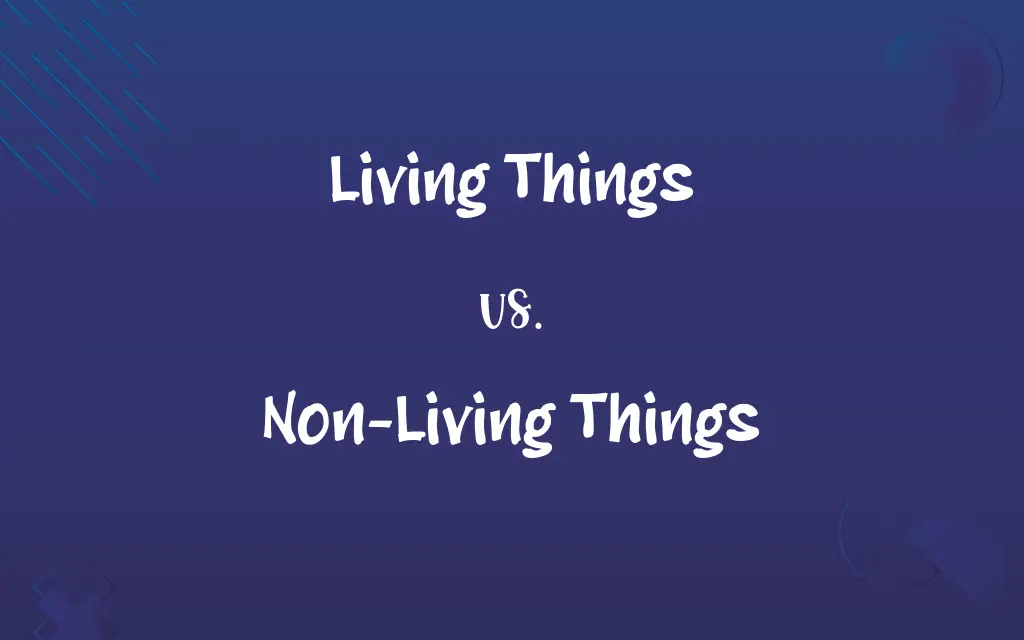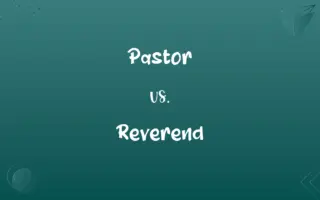Living Things vs. Non-Living Things: Know the Difference

By Shumaila Saeed || Published on January 23, 2024
Living Things are organisms that exhibit the characteristics of life, such as growth, reproduction, and metabolism, whereas Non-Living Things do not possess these life processes.

Key Differences
Living Things are characterized by their ability to grow, reproduce, and maintain homeostasis. They are biological entities capable of responding to stimuli, adapting to their environment, and undergoing metabolism. Non-Living Things, in contrast, do not possess these qualities. They do not grow, reproduce, or have a metabolism, and they do not respond to stimuli in the same way living organisms do.
Shumaila Saeed
Jan 23, 2024
Living Things encompass a vast range of organisms, from microscopic bacteria to large mammals, including humans. All these organisms share common life processes like respiration and digestion. Non-Living Things include inanimate objects like rocks, water, and man-made items like buildings and machinery, which do not exhibit any signs of life such as growth or reproduction.
Shumaila Saeed
Jan 23, 2024
The cells are the basic unit of life in Living Things, making them capable of complex biological processes. This cellular structure allows for functions like energy utilization and self-repair. Non-Living Things, however, are made up of atoms and molecules but do not have cells, thus lacking the functional complexity seen in living organisms.
Shumaila Saeed
Jan 23, 2024
Living Things have a lifespan; they are born, grow, reproduce, and eventually die. This life cycle is a fundamental characteristic of all living organisms. Non-Living Things do not have a lifespan in the biological sense. They may change or degrade over time due to physical or chemical processes, but they do not undergo a biological life cycle.
Shumaila Saeed
Jan 23, 2024
In terms of environmental interaction, Living Things actively interact with their environment and can adapt to changes, a key feature for survival and evolution. Non-Living Things, while they can be affected by environmental factors like temperature and pressure, do not adapt or evolve in response to environmental changes in the way living organisms do.
Shumaila Saeed
Jan 23, 2024
ADVERTISEMENT
Comparison Chart
Response to Stimuli
Can respond and adapt
Do not respond or adapt biologically
Shumaila Saeed
Jan 23, 2024
Environmental Interaction
Interact and adapt
Affected by, but do not adapt to, environment
Shumaila Saeed
Jan 23, 2024
ADVERTISEMENT
Living Things and Non-Living Things Definitions
Living Things
Living Things are organisms capable of growth, reproduction, and metabolism.
Plants are living things that grow and reproduce through seeds.
Shumaila Saeed
Jan 05, 2024
Non-Living Things
Non-Living Things are not composed of cells and do not have life processes.
A computer, being an artificial construct, is a non-living thing.
Shumaila Saeed
Jan 05, 2024
Living Things
Living Things maintain homeostasis through internal processes.
Humans regulate their body temperature, a trait of living things.
Shumaila Saeed
Jan 05, 2024
Non-Living Things
Non-Living Things do not undergo a biological life cycle.
Buildings deteriorate over time but do not have a life cycle like living things.
Shumaila Saeed
Jan 05, 2024
Living Things
Living Things are entities that respond to environmental stimuli.
Animals, as living things, react quickly to changes in their environment.
Shumaila Saeed
Jan 05, 2024
ADVERTISEMENT
Non-Living Things
Non-Living Things can be natural or man-made but lack life characteristics.
Cars, as man-made objects, are considered non-living things.
Shumaila Saeed
Jan 05, 2024
Living Things
Living Things undergo a life cycle of birth, growth, and death.
Butterflies show a complex life cycle, metamorphosing from caterpillars.
Shumaila Saeed
Jan 05, 2024
Non-Living Things
Non-Living Things do not exhibit growth, reproduction, or metabolism.
Rocks remain static over time, classifying them as non-living things.
Shumaila Saeed
Jan 05, 2024
Living Things
Living Things have cellular structures for various functions.
Bacteria, despite being single-celled, are classified as living things.
Shumaila Saeed
Jan 05, 2024
Non-Living Things
Non-Living Things do not respond to stimuli in a biological manner.
Water, although it reacts to temperature, does not adapt like living things.
Shumaila Saeed
Jan 05, 2024
Repeatedly Asked Queries
What are examples of Non-Living Things?
Examples include rocks, water, and man-made objects like chairs.
Shumaila Saeed
Jan 23, 2024
How do Living Things reproduce?
Living Things reproduce either sexually or asexually.
Shumaila Saeed
Jan 23, 2024
Do Non-Living Things have a metabolism?
No, they do not have metabolic processes.
Shumaila Saeed
Jan 23, 2024
Are Non-Living Things affected by the environment?
They are affected physically or chemically, but do not adapt biologically.
Shumaila Saeed
Jan 23, 2024
What defines Living Things?
Living Things are defined by growth, reproduction, and metabolism.
Shumaila Saeed
Jan 23, 2024
Do Living Things have cells?
Yes, Living Things are composed of one or more cells.
Shumaila Saeed
Jan 23, 2024
Can Living Things adapt to their environment?
Yes, Living Things can adapt to changes in their environment.
Shumaila Saeed
Jan 23, 2024
What is the lifespan of Living Things?
Living Things have varying lifespans, from days to centuries.
Shumaila Saeed
Jan 23, 2024
How do Living Things maintain homeostasis?
They maintain it through complex internal processes.
Shumaila Saeed
Jan 23, 2024
Do Non-Living Things have a lifecycle?
They do not have a biological lifecycle.
Shumaila Saeed
Jan 23, 2024
What role do Living Things play in ecosystems?
They are integral, interacting with each other and their environment.
Shumaila Saeed
Jan 23, 2024
Can Non-Living Things change over time?
They can change physically or chemically, but not biologically.
Shumaila Saeed
Jan 23, 2024
Can Non-Living Things perform biological functions?
No, they cannot perform biological functions like living organisms.
Shumaila Saeed
Jan 23, 2024
Are all Non-Living Things inanimate?
Yes, they are inanimate and do not possess life characteristics.
Shumaila Saeed
Jan 23, 2024
Are viruses considered Living Things?
Viruses are in a gray area, not fully classified as living or non-living.
Shumaila Saeed
Jan 23, 2024
Do Living Things need energy?
Yes, they require energy to sustain their biological processes.
Shumaila Saeed
Jan 23, 2024
Share this page
Link for your blog / website
HTML
Link to share via messenger
About Author
Written by
Shumaila SaeedShumaila Saeed, an expert content creator with 6 years of experience, specializes in distilling complex topics into easily digestible comparisons, shining a light on the nuances that both inform and educate readers with clarity and accuracy.








































































